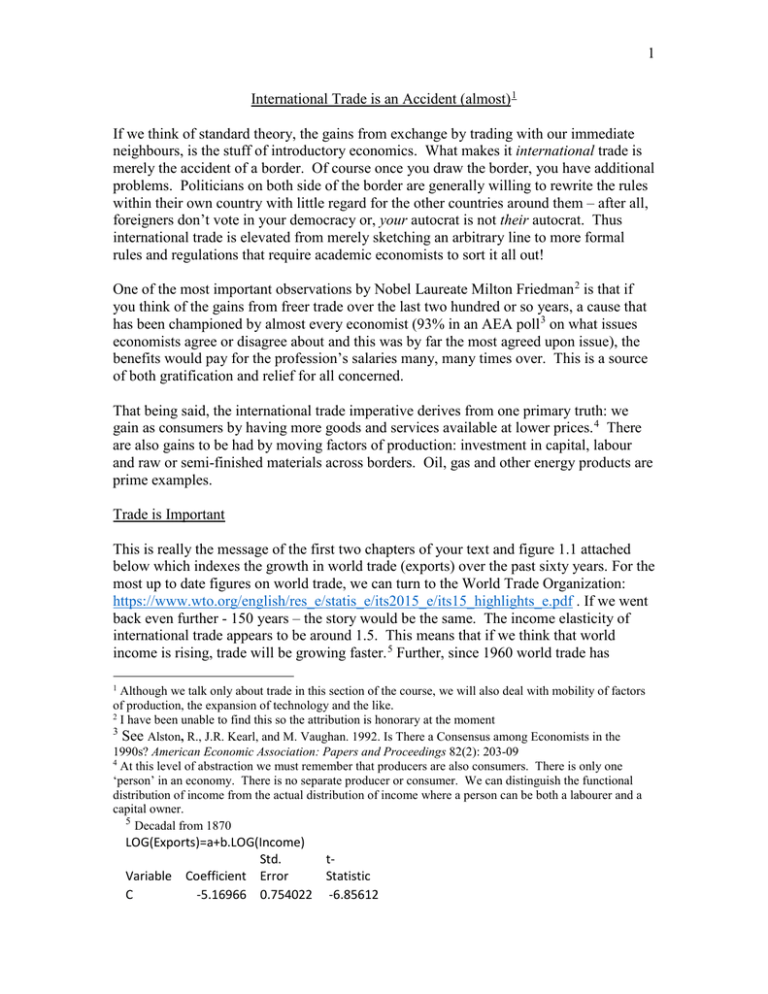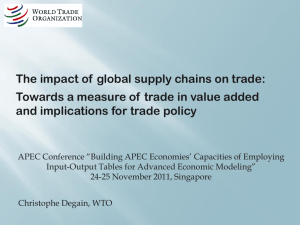1 International Trade is an Accident (almost)
advertisement

1 International Trade is an Accident (almost) 1 If we think of standard theory, the gains from exchange by trading with our immediate neighbours, is the stuff of introductory economics. What makes it international trade is merely the accident of a border. Of course once you draw the border, you have additional problems. Politicians on both side of the border are generally willing to rewrite the rules within their own country with little regard for the other countries around them – after all, foreigners don’t vote in your democracy or, your autocrat is not their autocrat. Thus international trade is elevated from merely sketching an arbitrary line to more formal rules and regulations that require academic economists to sort it all out! One of the most important observations by Nobel Laureate Milton Friedman 2 is that if you think of the gains from freer trade over the last two hundred or so years, a cause that has been championed by almost every economist (93% in an AEA poll 3 on what issues economists agree or disagree about and this was by far the most agreed upon issue), the benefits would pay for the profession’s salaries many, many times over. This is a source of both gratification and relief for all concerned. That being said, the international trade imperative derives from one primary truth: we gain as consumers by having more goods and services available at lower prices. 4 There are also gains to be had by moving factors of production: investment in capital, labour and raw or semi-finished materials across borders. Oil, gas and other energy products are prime examples. Trade is Important This is really the message of the first two chapters of your text and figure 1.1 attached below which indexes the growth in world trade (exports) over the past sixty years. For the most up to date figures on world trade, we can turn to the World Trade Organization: https://www.wto.org/english/res_e/statis_e/its2015_e/its15_highlights_e.pdf . If we went back even further - 150 years – the story would be the same. The income elasticity of international trade appears to be around 1.5. This means that if we think that world income is rising, trade will be growing faster. 5 Further, since 1960 world trade has 1 Although we talk only about trade in this section of the course, we will also deal with mobility of factors of production, the expansion of technology and the like. 2 I have been unable to find this so the attribution is honorary at the moment 3 See Alston, R., J.R. Kearl, and M. Vaughan. 1992. Is There a Consensus among Economists in the 1990s? American Economic Association: Papers and Proceedings 82(2): 203-09 4 At this level of abstraction we must remember that producers are also consumers. There is only one ‘person’ in an economy. There is no separate producer or consumer. We can distinguish the functional distribution of income from the actual distribution of income where a person can be both a labourer and a capital owner. 5 Decadal from 1870 LOG(Exports)=a+b.LOG(Income) Std. tVariable Coefficient Error Statistic C -5.16966 0.754022 -6.85612 2 expanded even more quickly. The income elasticity using per capita exports and per capita world income is 2.2! 6 There is of course another observation to be made about high income elasticities: when income falters, trade falters even more dramatically since a 1% drop in income leads to a 2.2% drop in trade. LOG(Y) 6 1.470501 0.044548 33.00939 LOG(EXPORTS) = -11.9 + 2.2*LOG(GDP). 3 The next table (1.3) illustrates the products being traded around the world and their value and the third table (1.5) describes the distribution of trade by country. 4 Canadians do a great deal of trade with the United States. We import about half of all our goods from the US and export about 78%. If we take the US out of the mix, then the remainder of Canada’s $416 billion of are distributed as below. Similarly we can plot Canadian imports without the US. All data are from the DOT. 14000 12000 10000 8000 6000 4000 2000 0 exports Canadian Exports Not Including the US: 2008 5 50,000 45,000 Canadian Imports Without the US: 2008 40,000 35,000 30,000 25,000 20,000 15,000 10,000 5,000 - So naturally we need to set about understanding what gives rise to the volume and value of trade. To do this, we need more than knowledge simple of the brute numbers of trade. We need to understand the theory of international trade. To do that, we need to review the economic theory that helps us understand trade in general and then more specifically international trade. That will be the task of the rest of the course. Contemporary Data The World Trade Organization (WTO) home page is: https://www.wto.org/index.htm . It is a portal into an extensive data base on trade related issues. For example, there are current world trade statistics: https://www.wto.org/english/res_e/statis_e/its2015_e/its15_toc_e.htm There are country by country statistics: https://www.wto.org/english/res_e/publications_e/trade_profiles15_e.htm As part of the report is an extensive Appendix that has data broken down in a variety of ways and even historical data as far back as 1950. https://www.wto.org/english/res_e/statis_e/its2015_e/its15_appendix_e.htm 6 The WTO also gives web locations (URL’s) for other organizations’ trade statistics: http://unstats.un.org/unsd/tradeserv/TFSITS/matrix.htm The WTO data are also relevant when we look at impediments to trade such as tariffs: https://www.wto.org/english/tratop_e/tariffs_e/tariff_data_e.htm and, non-tariff barriers to trade: https://i-tip.wto.org/goods/default.aspx?language=en There is a wealth of information on the web site and students may find the data useful in a variety of contexts. There are also data about international agreements and dispute settlement. There are of course many other interesting trade related data sets at various international organization such as the World Bank and the International Monetary Fund. The IMF’s Directions of Trade (DOT) for example catalogues each country’s trade with every other country! This is a rich source for many interesting questions.




